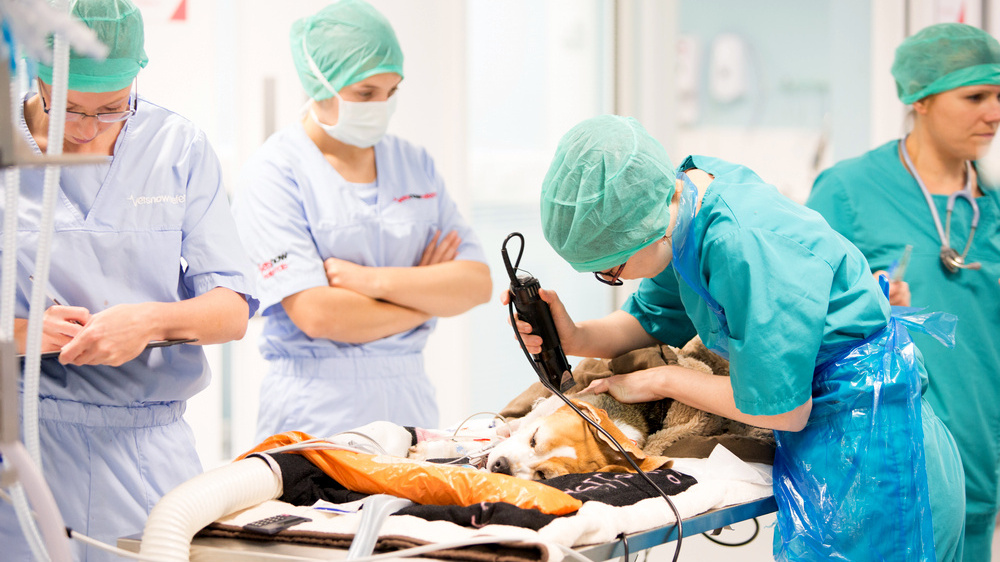
New insights offered on issues ranging from the effect of the full moon on dogs to the mortality of GDV patients
Over the past few years, evidence-based veterinary medicine (EBVM) has emerged as one of the most important topics of discussion within the profession.
Vets are also increasingly turning to EBVM to help make their clinical decisions easier, quicker and less prone to interference from poor quality studies.
More than 20 Vets Now vets and vet nurses – spread across the company’s 55 clinics and three emergency and critical care hospitals – took part in Vets Now’s own in-house inaugural EBVM programme.
Their remit was to embark on their own EBVM projects using, amongst other resources, data collected from 300,000 dogs and 120,000 cats that had presented to Vets Now in an emergency. The team were awarded RCVS Knowledge funding to support our goals.
Here are the findings from some of their projects:

Hypertonic saline solution on intracranial brain trauma
Alex Tischer, who is based in our Hemel Hempstead clinic, reviewed all the relevant published studies dating from 1986 to 2015, using data from a combined total of 159 cases.
Her knowledge summary concluded that the evidence shows that hypertonic saline solution is effective in the treatment of raised intracranial pressure after traumatic brain injury.

Mortality of patients presenting for GDV
Another study, conducted by Ava Firth, researched the mortality of patients who presented for gastric dilation-volvulus (GDV). Ava’s sought to understand the percentage of dogs presenting with GD/GDV who died or were euthanised at the time of initial consultation.
It found that patient survival rates fell to less than 50% when dogs presented for treatment three hours or more after displaying symptoms. The research concluded that GDV mortality rates were much better, therefore, in dogs who presented to an emergency vet as early as possible.

Aetiology and outcomes of dyspnoeic cats presented to emergency clinics
Coventry-based Amanda-Jane Rogers’s project sought to describe the population and outcomes of dyspnoeic cats presenting to primary out-of-hours practitioners and to compare it with previously-reported data.
The results of this study concluded that respiratory conditions occurred most frequently, but cardiac cases had the highest mortality rate.
This was the first large-scale study of cats presenting with dyspnoea in a first-opinion emergency setting. While the study has some limitations, the information should be useful to first-opinion veterinary practices.
Other articles on this topic

The lunar cycle effect on seizures
It is often proposed that a greater number of seizuring patients present during a full moon. In one of the more esoteric studies conducted by our EBVM researchers, Michelle Dawson, who works in our Hemel Hempstead clinic, investigated the effect of the full moon on seizure caseload presenting to emergency clinics.
Of the 788 cats and 3079 dogs looked at in the study, no statistically significant variation in caseload could be found between full moon nights and other nights. The lunar cycle did not appear to have any effect on the survival to discharge rate in either species.
This was the first study of the moon’s effect on the number of seizure cases in emergency clinics. Michelle hopes it will help address a commonly held belief among veterinary staff and clients and may guide staff advising owners about risk factors for seizure occurrence.

Treatment of Vitis vinifera in dogs presented to emergency clinics
Ingestion of grapes, raisins, sultanas and currants is a common intoxication in dogs and can lead to acute renal failure and death if untreated. Rachel Croft’s study analysed the treatment and short-term outcomes of dogs treated at out-of-hours emergency clinics for grape/raisin ingestion.
Some 855 cases were used in the study. The research showed that gastrointestinal signs were the most common clinical signs of grape/raisin poisoning. It also found that retrieval of grapes/raisins can occur more than six hours post ingestion if emesis is induced.

Common emergency presentations in puppies and kittens
Another study, conducted by Ide Gillespie et al, sought to discover the most common presentations among puppies and kittens and their associated mortality.
They found that gastrointestinal signs were most frequently seen in puppies whereas kittens most often presented post-trauma, or in a collapsed state.
From the research, it was apparent that puppies have a significantly higher survival rate than kittens. However, survival for both species appears to increase with age, with kittens under three-months-old having the poorest prognosis.

Most common small animal emergency problems in the UK
Another study by Ava Firth et al researched the most common presentations in companion animals to first opinion emergency clinics in the UK.
The epidemiological observational study aimed to identify the most common reasons for which pets present for acute illness. Among their many findings, Ava, along with some colleagues and researchers, identified that the presenting complaint of collapse or syncope carried the highest mortality rate in both dogs and cats.
The future
The Vets Now EBVM programme continues to gather pace and, with more than 30 members in the current team, 2018 looks set to be another busy year.
The team are currently working on a number of prospective and retrospective studies, knowledge summaries and research projects relating to such diverse topics as neonatal medicine, gastrointestinal markers, antibiotic stewardship, FLUTD, feline trauma, small animal exotic emergency presentations and thromboelastography.

